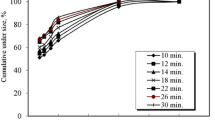Abstract
The requirements for clean water in marble processing are partially realized by treating and recycling slurry wastes from the cutting and processing plant. In this study, the flocculation of calcitic and dolomitic (21.2 % MgO) marble wastes was investigated using six flocculants with different molecular weights and anionic levels. Nine solutions between 0.1 and 2.5 mg/L were prepared, and marble waste samples were treated in natural, slightly acidic, and alkaline media. The anionic flocculants had a more dramatic effect on the slower-settling dolomitic marble than the calcitic marble. Calcite precipitation was better in an alkaline medium, while dolomitic marble precipitation was better at a slightly acidic pH of 6.
Zusammenfassung
Ein Teil des Frischwasserbedarfes in der Marmorverarbeitung wird durch Klärung und Rückführung des Prozesswassers der Schneide- und Verarbeitungsanlagen realisiert. In dieser Studie wurde die Flockung von kalzitischen und dolomitischen (21.2% MgO) Marmorabgängen untersucht. Sechs Flockungsmittel mit verschiedenen molekularen Gewichten und Anionengehalten wurden erprobt. Neun Lösungen zwischen 0.1-2.5 mg/L wurden erstellt. Marmorabgänge wurden in natürlichem, schwach sauren und alkalischem Medium behandelt. Die anionischen Flockungsmittel hatten im Vergleich mit Kalzitmarmor einen dramatischeren Effekt auf den langsamer absinkenden Dolomitmarmor. Das Ausfällen von Kalzit war in alkalischem Medium besser, wogegen die Präzipitation von Dolomitmarmor bei schwach saurem pH 6 besser war.
Resumen
Los requerimientos para limpieza de agua en el procesamiento de mármol son parcialmente realizados por tratamiento y reciclado de los lodos residuales que provienen de la planta de procesamiento y corte. En este estudio, se investigó la floculación de residuos de calcita y dolomita (21,2% MgO) usando seis floculantes con distintos pesos moleculares y niveles aniónicos. Se prepararon nueve soluciones entre 0,1-2,5 mg/L y las muestras de residuos fueron tratadas en medio natural, ligeramente ácido y alcalino. Los aniones floculantes tuvieron un efecto más significativo sobre el residuo de mármol dolomítico, de más lenta sedimentación, que sobre el mármol calcítico. La precipitación de calcita fue mejor en medio alcalino mientras que la de dolomita lo fue en un medio ligeramente ácido (pH 6).
摘要
大理石切剤¸加工工厂泥浆的处理与利用能够一定程度上弥补加工厂清水需求的不足。利用不同分子量和阴离子水平的六种絮凝剂研究了含方解石和白云石(21.2% MgO)泥浆的絮凝作用。事先制备9份浓度为0.1~2.5 mg/L溶涬分别在自然、微酸和碱性条件下进行大理石厂泥浆处理。阴离子絮凝剂对扩较慢的白云质大理婦³¥浆的絮凝作用比含方解石大理婦³¥浆效果明显。碱性环境利于含方解石泥浆扦,而弱酸环境(pH=6)利于含白云质泥浆扦。

Similar content being viewed by others
References
Beyazyüz PC, Önen V, Yel E (2011) Flocculation of wastewater from travertine processing plant. In: Onur AH, Konak G, Karakuş D, Tanrıverdi M, Özdoğan MV (eds) Proceedings of the 4th mining and environmental symposum, Chamber of Mining Engineers of Turkey, pp 273–279 (in Turkish)
Bouzahzah H, Benzaazoua M, Bussiere B, Plante B (2014) Prediction of acid mine drainage: importance of mineralogy and the test protocols for static and kinetic tests. Mine Water Environ 33(1):54–65. doi:10.1007/s10230-013-0249-1
Ersoy B (2003) Description of flocculants used in cleaning of waste water of marble processing plant. In: Ersoy M (ed) Proceedings of the 4th marble symposium, Chamber of Mining Engineers of Turkey, pp 449–462 (in Turkish)
Ersoy B (2005) Effect of pH polymer charge density on settling rate and turbidity of natural stone suspensions. Int J Miner Process 75(3–4):207–216. doi:10.1016/j.minpro.2004.08.011
Ersoy B, Alptekin AM, Sarıışık A, Gürcan S, Erkan ZE, Yıldız A (2005) The effect of different methods and different coagulants on turbidity removal from the wastewater of natural stone processing plant. In: Proceedings of the mining and environmental symposium, Chamber of Mining Engineers of Turkey, pp 117–125 (in Turkish)
Karaca Z (1997) Technical and economical optimization of marble processing plants. MSc Thesis, Dokuz Eylul Univ, Izmir, Turkey (in Turkish)
Karaca Z (2010) Water absorption and dehydration of natural stones versus time. Constr Build Mater 24(5):786–790. doi:10.1016/j.conbuildmat.2009.10.029
Katırcıoğlu D, Karaca Z, Önen V, Deliormanlı AH (2011) The relationship between flocculants and the chemical contents of two true marble types during slurry purifications. In: Medved M (ed) Proceedings of the 4th Balkan Mining Congress, pp 501–504
Onargan T, Köse H, Deliormanlı AH (2011) Marble. Chamber of Mining Engineers of Turkey, Ankara (in Turkish)
Sabah E, Cengiz İ (2004) The effect of ionic groups of polyacrylamide on the settling behaviour of coal preparartion plant tailings. In: Aydin H, Colak K (eds) Proceedings of the 14th Coal Congress, pp 133–140 (in Turkish)
Şener S (2007) Removal of suspended solid materials from the wastewater of natural dimension stone cutting plants by flocculation. J Sci Technol 1(2):234–244
Seyrankaya A, Mayaloglu U, Akar A (2000) Flocculation of marble from industrial wastewater and environmental consideration. In: Hicyilmaz C, Hosten C, Arol AI, Ozbayoglu G, Atalay MU (eds) Proceedings of the 8th international mineral processing symposium, pp 645–652
Simsek C, Karaca Z, Gemici U, Gunduz O (2005) The assessment of the impacts of a marble waste site on the water and sediment quality in a river system. Fresenius Environ Bull 14(11):1013–1023
Sivrikaya O, Kıyıldı KR, Karaca Z (2014) Recycling waste from natural stone processing plants to stabilise clayey soil. Environ Earth Sci 71(10):4397–4407. doi:10.1007/s12665-013-2833-x
Tao D, Groppo JG, Parekh BK (2000) Enhanced ultrafine coal dewatering using flocculation filtration processes. Miner Eng 13(2):163–171. doi:10.1016/S0892-6875(99)00162-4
Taşdemir T, Taşdemir A (2011) Application of flocculation and coagulation methods on wastewaters of marble processing plant. In: Onur AH, Konak G, Karakuş D, Tanrıverdi M, Özdoğan MV (eds) Proceedings of the 4th mining and environmental symposium, Chamber of Mining Engineers of Turkey, pp 293–299 (in Turkish)
Acknowledgments
The authors sincerely thank the editors for valuable suggestions that significantly improved this manuscript.
Author information
Authors and Affiliations
Corresponding author
Rights and permissions
About this article
Cite this article
Bayel, D.K., Karaca, Z., Onen, V. et al. The Relationship Between Mineral Content and Flocculant Characteristics for Slurry Waste Water Recycling at Marble Processing Plants. Mine Water Environ 35, 332–336 (2016). https://doi.org/10.1007/s10230-015-0367-z
Received:
Accepted:
Published:
Issue Date:
DOI: https://doi.org/10.1007/s10230-015-0367-z




